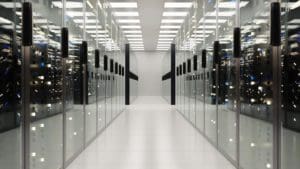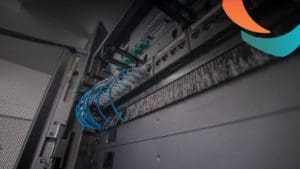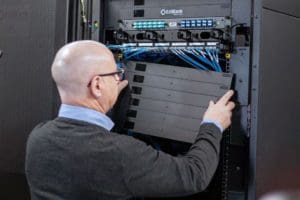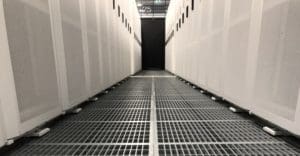Cooling efficiency is crucial for optimising the performance of your data centre while effectively managing energy consumption. At EziBlank, we understand the intricate balance between maintaining ideal thermal conditions and minimising power costs. Our cutting-edge blanking panels are designed to enhance airflow management, ensuring that your infrastructure operates at its peak. By investing in EziBlank solutions, you not only safeguard your technological investments but also contribute to a sustainable future. Discover how our innovative designs can transform your cooling strategy and deliver tangible results for your operations.
How Server Blanking Panels Improve Data Center Efficiency
Optimising data centre efficiency is a crucial task, and server blanking panels are an often-overlooked solution that plays a significant role. These panels help in managing airflow within server racks, preventing hot air recirculation and ensuring that cooling systems operate more effectively. By maintaining the proper thermal environment, blanking panels contribute to reduced energy consumption and lower operational costs, making them an essential component for data centres aiming for peak performance and sustainability.
Read More
Cold Aisle Containment Solutions & Products
Cold aisle containment is a highly effective strategy for improving the efficiency and performance of data centre cooling systems. This approach involves physically separating the cold air used for cooling servers from the hot exhaust air, typically by enclosing the cold aisle where the server fronts are located. By preventing the mixing of hot and cold air, cold aisle containment ensures that cooling is more targeted and efficient, reducing energy consumption and lowering operational costs. Products designed for cold aisle containment, such as doors, ceiling panels, and blanking panels, help maintain a stable, cool environment within the aisle, allowing data centres to operate more efficiently and sustainably. This solution is particularly valuable in high-density environments where cooling demands are significant.
Read More
How to create the perfect data center airflow management plan
Creating the perfect data centre airflow management plan is essential for optimising cooling efficiency, reducing energy consumption, and ensuring the longevity of your equipment. The process begins with a thorough assessment of the current airflow dynamics, identifying any hot spots or areas where air circulation is suboptimal. Key components of an effective plan include the strategic placement of blanking panels to prevent hot air recirculation, proper cable management to avoid airflow blockages, and the use of perforated floor tiles to direct cool air precisely where it’s needed. Additionally, implementing cold or hot aisle containment can further enhance airflow efficiency by separating hot and cold air streams. Regular monitoring and adjustments are crucial to maintaining optimal conditions as the data centre evolves. By focusing on these elements, you can create an airflow management plan that maximises performance and minimises costs.
Read More
Airflow Management Products
Airflow management products are essential tools for optimising cooling efficiency and maintaining the performance of data centres. These products include blanking panels, which are used to cover unused spaces in server racks, preventing hot air from recirculating and ensuring that cool air is directed precisely where it’s needed. Perforated floor tiles are another key product, allowing controlled cool air delivery from beneath the raised floor to the servers. Additionally, air curtains and containment systems, such as hot and cold aisle containment solutions, help separate hot and cold air streams, further enhancing cooling efficiency. By implementing these airflow management products, data centres can reduce energy consumption, improve equipment longevity, and maintain optimal operating conditions.
Read More
Data Center Cooling: Best Practices
Implementing best practices for data centre cooling is crucial to maintaining efficiency, reducing energy costs, and ensuring the longevity of equipment. Key practices include optimising airflow by using blanking panels to fill unused rack spaces, which prevents hot air recirculation and ensures that cool air reaches the servers effectively. Additionally, employing hot and cold aisle containment systems can further enhance cooling efficiency by separating hot exhaust air from cold intake air, reducing the workload on cooling systems. Regular maintenance of HVAC systems and air filters is essential to ensure that cooling units operate at peak performance. Monitoring temperature and humidity levels in real-time allows for adjustments that prevent overheating and ensure optimal conditions. By following these best practices, data centres can achieve significant improvements in cooling efficiency, leading to lower operational costs and improved equipment performance.
Read More
Blanking Panels: The Ultimate Guide
Blanking panels are a crucial yet often overlooked component in data centre management, playing a vital role in optimising airflow and enhancing energy efficiency. These panels are designed to fill the empty spaces in server racks, preventing the recirculation of hot air into the cold aisle, which can otherwise lead to hotspots and reduced cooling efficiency. By directing cool air precisely to where it’s needed and ensuring that hot air is properly expelled, blanking panels help maintain optimal operating temperatures, reduce the workload on cooling systems, and ultimately lower energy costs. Available in various sizes and materials, blanking panels are easy to install and offer a cost-effective solution for improving data centre performance. Regular use and proper installation of blanking panels not only contribute to a more efficient and reliable data centre but also extend the lifespan of critical IT equipment.
Read More
Profiling your data centre for greater efficiency
Profiling your data centre is a crucial process for understanding its current performance, identifying inefficiencies, and planning for future improvements. This involves a comprehensive analysis of various aspects of the data centre, including power usage, cooling effectiveness, airflow management, and overall infrastructure performance. By profiling, data centre managers can pinpoint areas where energy is being wasted, such as hot spots caused by poor airflow or overcooling. Tools like temperature sensors, power meters, and monitoring software are often used to collect data that provides insights into how well the data centre is operating. With this information, targeted strategies can be implemented, such as optimising airflow with blanking panels or adjusting cooling systems, to enhance energy efficiency, reduce costs, and improve the reliability and lifespan of the equipment. Profiling is an essential step in ensuring that a data centre operates at peak efficiency and is prepared to meet future demands.
Read More
High performance directional floor tiles for high density equipment racks
High-performance directional floor tiles are a critical component in data centre design, specifically engineered to optimise airflow and cooling efficiency. These tiles are strategically placed within raised floor systems to direct cool air from the underfloor plenum towards the server racks, ensuring that the air reaches the equipment that needs it most. By guiding airflow precisely, directional floor tiles help maintain consistent temperatures across the data centre, prevent hotspots, and reduce the workload on cooling systems. This leads to more efficient cooling, lower energy consumption, and improved overall performance of the data centre. Incorporating these tiles into a data centre's design is an effective way to enhance both energy efficiency and operational reliability.
Read More
